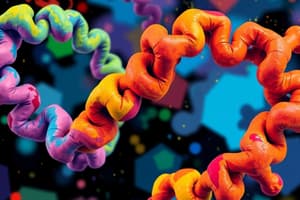Podcast
Questions and Answers
Explain the primary structure of a protein and its significance in determining the protein's function.
Explain the primary structure of a protein and its significance in determining the protein's function.
The primary structure of a protein refers to the sequence of amino acids in a polypeptide chain. It is significant in determining the protein's function because any alteration in the sequence of amino acids can affect the function of the protein.
Describe the formation and significance of secondary structure in proteins.
Describe the formation and significance of secondary structure in proteins.
The secondary structure of a protein refers to local folded structures that form within a polypeptide due to interactions between atoms. It occurs when negatively charged oxygen atoms interact with positively charged hydrogen atoms to form hydrogen bonds. The most common types of secondary structures are the α helix and the β pleated sheet. The secondary structure is significant as it contributes to the overall shape and stability of the protein.
How does the DNA of a cell influence the primary structure of a protein?
How does the DNA of a cell influence the primary structure of a protein?
The DNA of a cell determines the primary structure of a protein by instructing the cell to add certain amino acids in specific quantities in a certain sequence. This affects the shape and therefore the function of the protein.
Differentiate between fibrous proteins and globular proteins in terms of structural complexity.
Differentiate between fibrous proteins and globular proteins in terms of structural complexity.
Explain the role of hydrogen bonds in maintaining the secondary structure of proteins.
Explain the role of hydrogen bonds in maintaining the secondary structure of proteins.
Flashcards
Primary Structure of a Protein
Primary Structure of a Protein
The sequence of amino acids in a polypeptide chain.
Secondary Structure of a Protein
Secondary Structure of a Protein
Local folded structures within a polypeptide chain formed by hydrogen bonds between oxygen and hydrogen atoms. Examples: alpha helix and beta pleated sheet.
DNA's Influence on Primary Structure
DNA's Influence on Primary Structure
DNA provides the instructions for the order and number of amino acids in a protein chain.
Fibrous Proteins
Fibrous Proteins
Signup and view all the flashcards
Globular Proteins
Globular Proteins
Signup and view all the flashcards
Study Notes
Primary Structure of Proteins
- Composed of a linear sequence of amino acids linked by peptide bonds.
- The specific order of amino acids (polypeptide chain) determines unique properties and function of the protein.
- Mutations or alterations in the amino acid sequence can lead to changes in protein function, potentially resulting in diseases.
Secondary Structure of Proteins
- Formed through hydrogen bonding interactions between backbone atoms in the polypeptide chain.
- Common secondary structures include alpha-helices and beta-pleated sheets.
- Provides structural stability and impacts the overall shape of the protein, influencing its biological activity.
Influence of DNA on Primary Structure
- DNA contains the genetic code that dictates the sequence of amino acids in a protein.
- Messenger RNA (mRNA) transcribes the DNA sequence and translates it into an amino acid sequence during protein synthesis.
- The accuracy of this translation is crucial for correct protein structure and function.
Fibrous vs. Globular Proteins
- Fibrous proteins have elongated, rigid structures and are typically less complex; examples include collagen and keratin.
- Globular proteins are more compact and spherical, allowing for a diverse range of functions; examples include enzymes and antibodies.
- Structural complexity in globular proteins contributes to their functional versatility.
Role of Hydrogen Bonds in Secondary Structure
- Hydrogen bonds are crucial for stabilizing secondary structures by forming between the carbonyl oxygen of one amino acid and the amide hydrogen of another.
- These bonds help maintain the folded shape of proteins, allowing them to carry out specific biological functions efficiently.
- Disruption of hydrogen bonding can lead to loss of structural integrity and functionality.
Studying That Suits You
Use AI to generate personalized quizzes and flashcards to suit your learning preferences.




